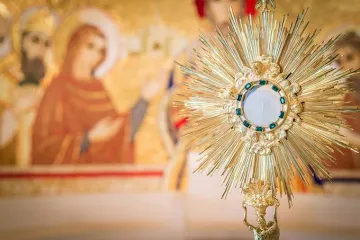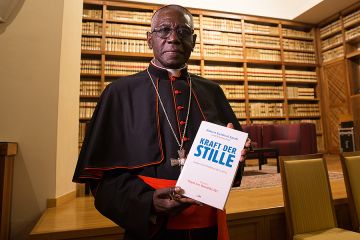Crookston, Minn., Apr 20, 2022 / 15:19 pm
“Providential” is the word that Bishop Andrew Cozzens of Crookston used to describe the April 25 release of “ALIVE: Who is there?”, a movie highlighting the transformative power of the Eucharist.
He said the movie is timed perfectly for this summer’s kick off to the U.S. bishops’ Eucharistic Revival, which Cozzens is leading in his capacity as U.S. bishops’ conference chair on evangelization and catechesis. Cozzens, who offers exclusive commentary in the bonus features of the film for U.S. audiences, spoke to CNA April 12 about his excitement for the movie, while elaborating further on his thoughts about topics such as disbelief in the Eucharist, reverent liturgy, the ad orientem posture, and practices for the reception of Holy Communion.
“I think it is a wonderful time as we're preparing to launch the Eucharistic revival to have such a powerful movie about people's encounter with Jesus and the Eucharist,” Cozzens said.
The movie’s one-day-only showing in the United States on April 25 marks the first time that English speaking audiences will be able to read along with subtitles, as it was directed and produced by Spanish filmmakers. Tickets for the 90-minute-long, Spanish-language documentary, which is subtitled in English, can be bought through the movie’s content distributor in the United States, Fathom Events.
Being aired in all 50 states and Washington D.C., the movie features the testimonies of five men and women who share how the true presence of Christ in the Eucharist has transformed their lives. Negotiations are underway in Canada and Australia to distribute the film to English speaking audiences in those countries as well.
Cozzens, who said he hopes everyone will see the movie, praised the film's mode of using testimony to teach about the Real Presence of Christ in the Eucharist. “When one person tells me about the reality of Jesus, especially his Presence in the Eucharist, that helps me believe in Jesus' own words and what those words could mean for me,” he said.
Do this and the Real Presence will become clear to you
Commenting further on the Real Presence, Cozzens said that for those who haven't had a life-changing experience in eucharistic adoration, he would tell them that “in order for faith to be real, I don’t always have to have an emotional experience and real faith will transform things over time.”
“I would also say what Jesus says: ‘Seek and you will find. Knock and the door will be opened. Ask and you will receive.’ And that really means keep on seeking, keep on asking, and as you continue to pursue Jesus and his presence in the Eucharist, it will become clear to you,” he added.
Two fundamental reasons for disbelief
Cozzens said he thinks there are a couple “fundamental reasons” why there are such high rates of disbelief in the Real Presence, among both Catholics and non-Catholics.
First, Cozzens said that modern culture has fallen into a heresy of what he calls “scientism” and has lost a “sacramental worldview.” Cozzens said that people struggle to understand the sacraments, which is “God's very life being communicated through this physical, tangible reality.”
The second reason for disbelief is bad catechesis, Cozzens told CNA.
“More than 10 years ago, the bishops really sort of tried to take by the handle catechesis in our country because they realized that several things in common catechetical texts were misrepresenting the truth about Catholic theology and one of those was the Eucharist,” he said.
“That's where the bishops started this very intensive catechism review for all catechetical texts and we're still getting our hands around all that, but it pointed to a problem that was very real in catechesis,” he added. “And some of that reality in catechesis also really flowed into our liturgy.”
Cozzens said that the liturgy of the Mass has not always had true reverence “that would help to carry forth the meaning of the truth of both the sacrifice of the Mass and Jesus' presence and the Eucharist.”
(Story continues below)
Cozzens said that at times “we placed more emphasis on the communal dimension of the liturgy, which is a very important dimension, but sometimes to the detriment of the reality of what's happening at the Mass and who we're encountering.”
How to restore belief in the Eucharist
“Good liturgy follows the General Instruction of the Roman Missal,” Cozzens said, while noting that the General Instruction allows for variations within the liturgy. He said if the Missal is followed, “that alone contributes to reverence of the Eucharist.”
When asked if liturgical changes such as Communion in the hand and celebration versus populum had contributed to disbelief in the Eucharist, Cozzens said, “I am hesitant to believe that certain particular ritual changes will solve all our problems.”
Cozzens said he believes that “we ought to receive Communion reverently,” while adding that he has seen people receiving on the hand with so much reverence that it has brought him to tears “because you can tell how much they believe in Jesus in the real presence.”
“I also think it's very beautiful when people receive Communion on the tongue, or even when people receive Communion kneeling and I appreciate the reverence that they're showing for Jesus in the Blessed Sacrament there,” he said.
Cozzens said that he trusts the Church in its judgement to permit Communion on the hand and Mass said versus populum, and noted that there “may come a day when the Church in general says, ‘yeah, we think it's better to go back to Communion on the tongue.’”
However, he said it would be difficult to say Communion on the hand was a mistake, “because a lot of evidence that we have shows that Communion on the hand preceded Communion on the tongue for centuries.”
Cozzens praised the writings of Benedict XVI on Mass said ad orientem, which communicated his thoughts that “it would be too much of a dramatic change to try to change that back, at least right now and that it was better to try to do the versus populum liturgy well because something was gained for many people in their experience of the liturgy by being able to see more of what the action of the priest is.”
Cozzens told CNA that people often bring concerns to him about irreverent liturgy, and liturgical abuse.
He said that he recommends to those people that they sit for an hour in front of the Blessed Sacrament in adoration once a week and that they “offer that holy hour for the struggles that their parish is having and for the people in [their] parish.”
Anger is a normal reaction when holy things are not treated properly, Cozzens said, but, “that kind of anger needs to be converted into deeper love and sacrifice in order to be able to be used by the Lord in a spiritual, for the good of his Church.”
Cozzens also recommends starting a small group with friends to study the Eucharist and sit in adoration together as a witness.
“I think it's wonderful that [the movie] is in Spanish because we have so many Latino Catholics in the United States, many of them great lovers of our Lord in the Eucharist,” Cozzens said.
He said that there are many English and Spanish speakers whom the movie could benefit by giving them a deeper understanding of the Eucharist.






